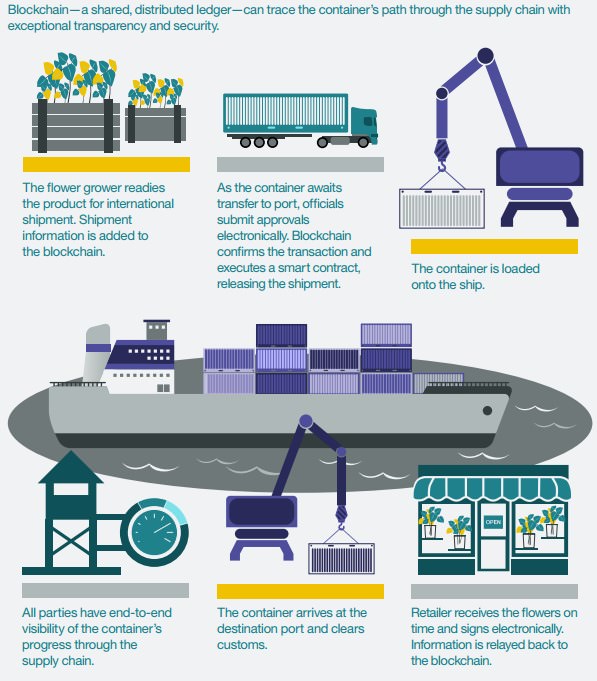The popularity of bitcoin among the internet world spurred many to look at the underlying technology application. What makes bitcoin ungoverned, stateless and independent, a currency the world is so actively trading daily without regulation by any agency? Why are financial institutions so involved in using blockchain technology to develop integrated banking applications? Are there other business applications for blockchain technology? What is all this mind bending excitement about blockchain technology? Let us run though some of the facts.

Table of Contents
Blockchain Technology for Supply Chain Management
1. A blockchain record cannot be controlled by a single entity
Incredible as it sounds, you need to take control of more than 51% of all the networked computers controlling the blockchain to make a “false” record. Now image if your network is a million strong computers, a seemingly impossible event. From a single computer, a request to add can only be processed, and also to view the current blockchain record.
2. Information recorded is shared by a large number of entities
So if one computer is corrupted for some reason and is offline, the other computers in the blockchain network will still maintain the blockchain record. As mentioned earlier, the technology dictates that each computer in the blockchain network will have a copy of the blockchain record. This ensures that no matter what happens, there is a build in fail safe in information records, be it man made or natural equipment failures. This useful feature become critical if your supply chain system is connected worldwide, having a decentralised data system like blockchain technology will make it robust to any centralised system failures, making information recovery swift ensuring continuous supply chain operations.
3. Information recorded in a blockchain cannot be corrupted
The programmed protocol of a blockchain record does not allow for modification of entries already added previously. Example, if an earlier entry accepted by the blockchain record is “10 apples 1200hrs 14April2017” you cannot erase this entry or overwrite it. You can only add the next entry of maybe “6 oranges 1530hrs 16April2017”, the history keeps adding with no subtraction. Which bring us to the point that blockchain technology ensures information integrity which is temper-proof to a higher degree. This comes useful for supply chain information systems that are reliant on corrupt proof information at all nodes of the supply chain system. Examples of this use would be like tracking of perishables like meats along a cold chain supply system where temperature integrity is vital to food safety. Or maybe pharmaceuticals, where traceability and manufacturing origin is vital to prevent “fake products” from distribution in a market where copy-cat products are rampant.
4. Large network of computers form governing body to oversee integrity of the blockchain record
Durability, robustness and self-governing (a kind of computer automation) of blockchain technology is all dependent on the infinitely large number of computers in the blockchain network. The larger the network the value quotient of durability, robustness and self-governing strengths will increase. Having said this, it does not make sense if your blockchain network consist of less than 50 computers. The smaller the grouping of computers, are you sure you need blockchain technology? Maybe sticking to current sever network systems will do fine for you.
5. The governing programme can be set to self-audit in regular intervals to maintain the integrity of the blockchain record
Self-auditing in blockchain technology is to ensure that each computer in the blockchain network is having the same up-to-date blockchain record. The frequency can be defined, as an example, currently the bitcoin blockchain record is said to “refresh” every 10 minutes along with the allocation of 25 bitcoins rewards for the “mining” efforts to its blockchain network. For supply chain management, the automation to self-check ensures integrity of all information shared by all points of access in your supply chain network.
6. Blockchain records can be programmed to act only if certain conditions are fulfilled – “Smart contracts”
This is where the functional value of blockchain technology increases. The conditions or criteria for an action to record and act upon can be programmed. In general, you can set criteria to accept a record to be entered into a blockchain and also set criteria such that once fulfilled then it activates another event. This will be explained next in applications.
Possible Applications for Supply Chain Management
1. Product trail recording from origin to customer
The ultimate product traceability tool. With blockchain recording for a push system, the raw material information will be chained to the production batch information and chained to the quality inspection information and chained to the packaging batch and chain to shipment date and chained to last mile delivery record and chained to customer date received date and invoice. This type of recording is ideal for aerospace components, pharmaceuticals, food safety control, medical devices, etc.
2. Use of Smart contracts to execute an action when criteria is fulfilled
An example of a purchase where payment is in stages like a 10% up front and 90% upon receiving item. So the 10% down payment triggers the build of the product in blockchain records. All the subsequent activities get recorded to the blockchain. Once the item gets received by the customer an auto release from the bank is initiated for the balance 90% payment. This can only happen only if all the required activities are fulfilled earlier like commissioning, quality acceptance, safe delivery to customer and finally digitally acceptance received by customer, blockchain technology ensures this.
3. Enables peer-to-peer data transfer or payments without a governing host
Blockchain technology allows for secure transfer of data or electronic payment without the use of a central host. With a two key encryption for the sender and receiver, the blockchain network then packs the blockchain across the internet and the receiver then receives the data or payment without any “middle man”.
The full content is only visible to SIPMM members
Already a member? Please Login to continue reading.

